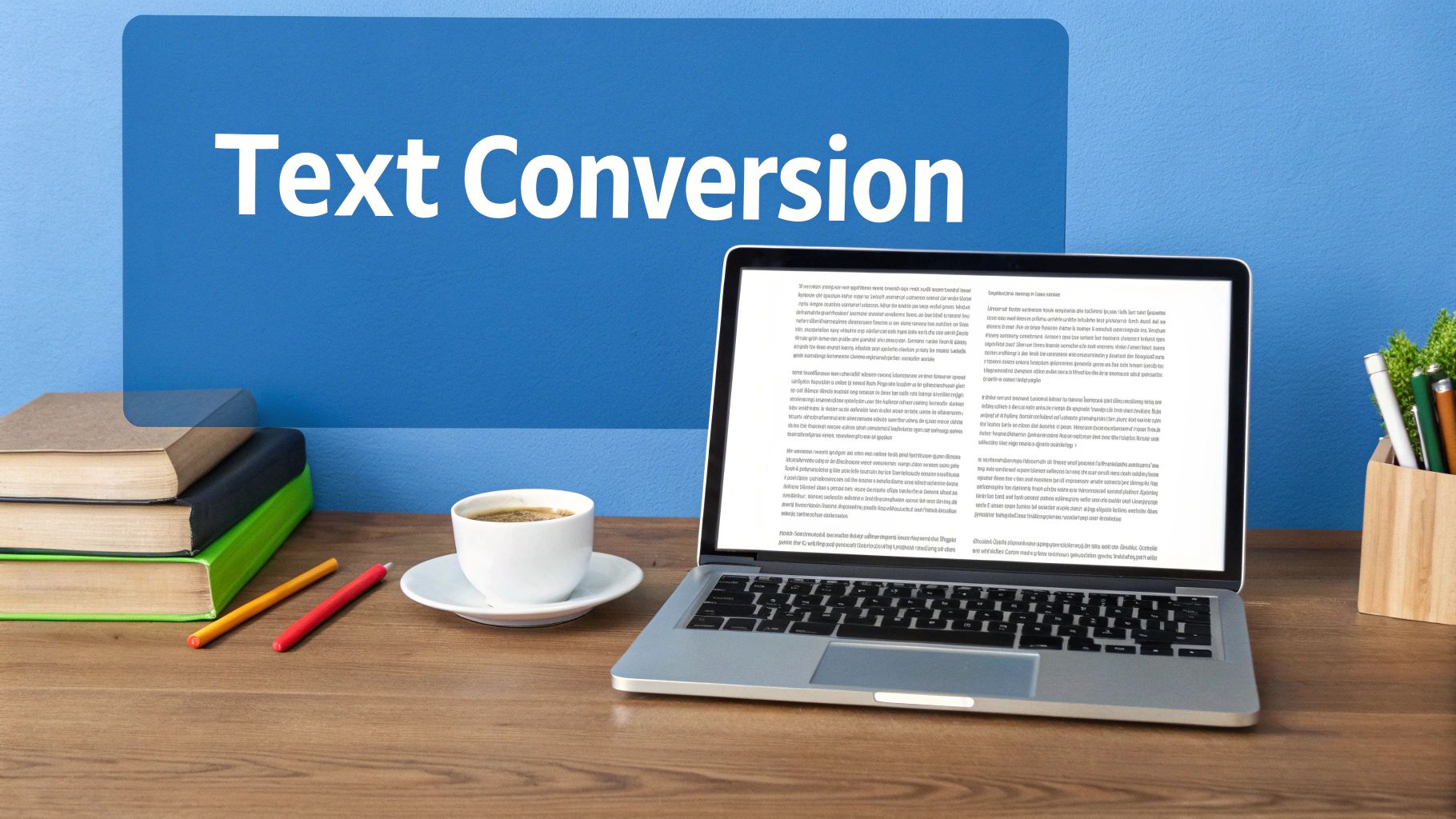Understanding the Evolution of AI Text Conversion

In recent years, AI writing tools have changed how we create content by offering rapid text generation capabilities. While these tools excel at producing content quickly, they often miss the natural flow and authenticity that comes from human writing. This gap has led to the development of AI to human text converters – specialized tools that polish AI-generated content to sound more natural and engaging while maintaining efficiency at scale.
The Rise of AI Text Conversion Technology
The development of AI text conversion builds on breakthroughs in neural networks. A key milestone came in late 2016 with neural machine translation, which used extensive neural networks and large datasets to generate more human-like text. This foundation enabled more advanced text conversion tools. The release of ChatGPT sparked growing interest in technology that could refine AI content to match human writing patterns. By 2023, tools like AI To Human Text Converter gained widespread use for improving readability and authenticity while avoiding AI detection.
Refining AI-Generated Content for Authenticity
These converters use several methods to enhance AI text quality. Tone adjustment helps match the emotional style to the content's purpose. The tools also focus on context preservation to maintain accurate meaning throughout conversion. Additionally, they improve natural language flow by eliminating the robotic patterns common in AI writing.
The Future of Human-AI Collaboration in Content Creation
Content creation is moving toward an effective partnership between human creativity and AI capabilities. AI to human text converters enable teams to produce more content while keeping the human touch that engages readers. This balanced approach helps organizations scale their content without losing quality or authenticity. As these tools become more refined, they will offer content creators even more precise control over how AI-generated text reads and feels to human audiences.
Essential Features That Drive Natural Content Creation

AI to human text converters help make AI-written content sound more natural. Let's explore the key features that make these tools truly effective at enhancing written content, so you can choose the right converter for your needs.
Tone Adjustment: Crafting the Right Voice
Tone adjustment is one of the most important capabilities. This feature lets you modify how the text comes across emotionally – for instance, changing formal academic writing into a more casual, conversational style. Having this control helps ensure your content connects with readers in just the right way for your specific audience and platform.
Context Preservation: Maintaining Accuracy and Meaning
When converting AI text to sound more human, keeping the original meaning intact is critical. That's where context preservation comes in. Good converters look at the full text, not just individual sentences, to maintain the core message while making stylistic improvements. This prevents mistakes or misinterpretations that could hurt your credibility.
Natural Language Flow: Enhancing Readability and Engagement
The best converters do more than fix grammar – they create natural language flow. This means restructuring sentences, mixing up sentence length, and adding smooth transitions to make the writing feel more organic. The result is content that reads smoothly and keeps readers engaged, rather than sounding robotic and stilted. For more writing tips, check out this guide on How to master paraphrasing.
Evaluating AI to Human Text Converters: Beyond Marketing Claims
With so many tools available, it's important to evaluate them based on actual performance rather than marketing promises. Test different converters with your own sample text to see how well they handle your specific needs. Focus on output quality, the level of control you get, and how well they maintain accuracy and authenticity. Taking time to assess these key aspects will help you pick the right converter to improve your content.
Mastering the Art of Content Conversion
Converting AI text into engaging, human-quality content requires skill and attention to detail. This section explores practical techniques used by content creators to transform AI writing while preserving accuracy and adding an authentic human voice.
Preparing Your AI-Generated Text for Conversion
Good preparation makes all the difference when converting AI text. Just as a chef prepares ingredients before cooking, you need to set up your content for success. Start by clearly defining your target audience and content goals. Review the AI text carefully to fix any obvious errors in logic or flow. This initial cleanup helps the conversion process focus on improving style rather than fixing basic issues.
Refining the Content with AI to Human Text Converter Tools
Once your text is ready, choose an AI-to-human converter that matches your needs. Different tools have different strengths – some excel at adjusting tone while others maintain technical accuracy better. Test platforms like SmartStudi's paraphrasing tool to find the right fit. Take time to customize the settings rather than using defaults. Adjust the tone settings to match your brand voice, whether casual or professional. Watch how the tool handles complex ideas and industry terms to ensure quality output.
The Importance of Human Review and Editing
Even the best AI converters need a human touch at the end. Read through the converted content carefully to spot any awkward phrases or subtle errors. Consider whether the writing truly speaks to your audience's needs and interests. Your expert knowledge helps ensure the final piece feels genuine and compelling. Think of the AI converter as your first draft – you provide the critical final polish that makes the content shine.
Maintaining Consistency and Style Across Larger Projects
For bigger content projects, keeping a consistent voice throughout is key. AI converters help maintain this consistency when you use the same settings across pieces. Create clear style guidelines for your team that outline preferred language, tone, and examples. This helps everyone produce unified content that builds trust with readers. Regular reviews ensure all pieces meet your quality bar, regardless of who wrote the initial draft or which AI tools helped along the way.
Creating Content That Genuinely Connects

A great AI text converter does more than fix grammar – it helps content make a real impact by focusing on key elements like tone, pacing, and structure. When these elements work together effectively, they create writing that resonates with readers and drives results.
Writing for Your Specific Audience
The foundation of engaging content is understanding exactly who you're writing for. For instance, technical audiences often need precise, detailed information, while general readers connect better with a casual, conversational style. An AI text converter becomes most valuable when it helps adjust content to match your audience's needs and preferences.
Making Content Easy to Read and Follow
Good pacing guides readers smoothly through your content. Quick, direct sentences create energy and momentum, while longer sentences allow for deeper exploration of ideas. Clear organization with headers, subheads, and bullet points makes information easier to scan and understand. These structural choices help readers stay engaged from start to finish.
Combining Facts with Human Connection
While accurate information matters, purely technical writing can feel cold and distant. Adding personal elements – like relevant stories, examples from experience, or direct questions to the reader – helps create an emotional connection. The best content finds the sweet spot between being informative and relatable. You might be interested in: How to master summarizing with our tool.
Measuring Success Through Data
Tracking how content performs gives clear insights for improvement. Key metrics like time on page, bounce rates, and social sharing show what's working. Reader comments and survey responses provide direct feedback about the content's impact. This data helps refine your approach and use AI text conversion more effectively.
Simple Ways to Improve Your Content
Several proven techniques can make AI-converted content more engaging. Visual elements break up text and capture interest. Varied sentence patterns keep readers' attention. Strong calls to action guide next steps. Here are key tips:
- Mix up sentence structure: Combine short and long sentences for natural flow
- Add helpful visuals: Include relevant images and graphics
- Guide reader actions: End with clear next steps
By applying these methods thoughtfully and analyzing what works best, you can create content that truly connects with readers while achieving your goals. Focus on making genuine connections through valuable information presented in an engaging way. This human element is what sets truly outstanding content apart.
Building Trust Through Authentic Content
Building Trust Through Authentic Content

While AI text converters offer useful ways to improve content creation, maintaining reader trust requires thoughtful and strategic use of these tools. The key is creating genuinely helpful content while being open about how AI assists the writing process. Let's explore practical ways to balance AI capabilities with authentic communication.
Transparency and Disclosure: Building Trust With Your Audience
Being upfront about AI use can strengthen your credibility rather than diminish it. Though not always mandatory, explaining how you incorporate AI tools shows respect for your readers and commitment to ethical practices. Consider adding a simple note describing how AI helps enhance your writing process – for example, mentioning its role in brainstorming ideas or creating initial drafts.
Creating Content That Stands Up to Scrutiny
True authenticity involves more than just passing AI detection tests. Focus instead on delivering real value to your audience. Ask yourself: Does this content help solve problems? Answer key questions? Share meaningful insights? Content that genuinely connects with readers builds far stronger relationships than content designed solely for search engines.
Balancing Efficiency and Authenticity: A Sustainable Approach
Tools like SmartStudi's paraphrasing feature can help create content more efficiently. However, maintaining quality requires viewing AI as a helpful assistant rather than a replacement for human insight. Expert review and editing remain essential for adding nuanced perspective and ensuring the content resonates with readers. This partnership between human expertise and AI capabilities offers a practical way to scale content while preserving authenticity.
Ethical Decision-Making in Content Conversion
As AI writing technology advances, considering the ethical implications becomes increasingly important. Here are key questions to guide your content development:
- Purpose: What main goal does this content serve – informing, persuading, entertaining? Ensure AI use aligns with this intent.
- Audience: Who are you writing for and what do they expect regarding authenticity and transparency?
- Accuracy: How will you verify that AI-converted content remains factually correct?
- Originality: Does the content maintain enough unique perspective to avoid plagiarism concerns?
By carefully considering these aspects while focusing on genuine audience connection, you can effectively use AI text converters while maintaining high content standards. This approach helps build lasting trust and establishes you as a reliable information source. Most importantly, creating authentic content that truly helps readers forms the foundation of any effective content strategy.
Measuring Impact and Optimizing Performance
When you've used an AI to human text converter, you need to know if it actually worked. Success requires careful analysis of how the converted content performs – both in engaging readers and ranking in search results. Let's explore practical ways to measure content effectiveness and use data to make improvements.
Key Metrics for Evaluating Converted Content
The most effective content teams look at both numbers and feedback to understand performance. The numerical data shows exactly how people interact with the content:
- Engagement Stats: Look at metrics like shares, comments, and time on page to see if readers find the content valuable and interesting
- Conversion Numbers: Track how many readers take desired actions like subscribing or purchasing to measure persuasiveness
- Search Rankings: Monitor traffic, keyword positions, and backlinks to see how well the content performs in search engines and meets user intent. Learn more about measuring results here: How to master getting better results with our platform
Reader feedback provides crucial insights that numbers alone can't capture:
- Direct Comments: Use surveys and comment sections to learn what readers actually think about clarity, tone and helpfulness
- Split Testing: Compare different content versions to find what resonates best with your audience based on real engagement data
Building a Continuous Improvement Cycle
Getting better results requires an ongoing process of measuring, analyzing and refining. Here's a simple framework:
- Track Performance: Gather key metrics on how your content is doing
- Find Patterns: Look for trends and opportunities in the data
- Test Changes: Try different approaches to tone, structure and visuals
- Measure Impact: See how the changes affected performance and keep improving
By consistently studying what works and making smart adjustments, you can create content that truly connects with readers and achieves your goals.
Want to start creating more polished, engaging content? SmartStudi offers AI writing tools designed specifically for students. Check out SmartStudi today!
